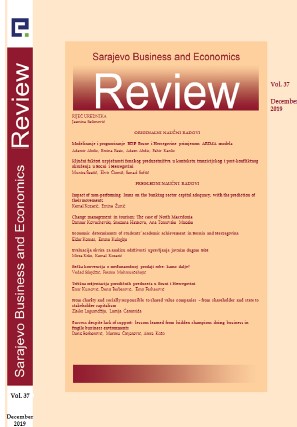COMPARISON OF STRUCTURAL EQUATION MODELLING AND MULTIPLE REGRESSION TECHNIQUES FOR MODERATION AND MEDIATION EFFECT ANALYSIS
COMPARISON OF STRUCTURAL EQUATION MODELLING AND MULTIPLE REGRESSION TECHNIQUES FOR MODERATION AND MEDIATION EFFECT ANALYSIS
Author(s): Lejla Turulja, Nijaz BajgorićSubject(s): Business Economy / Management, Methodology and research technology
Published by: Ekonomski fakultet u Sarajevu
Keywords: structural equation modeling; multiple regression; SEM; MR; innovation;
Summary/Abstract: Multiple regression (MR) is a well-recognized technique that has been widely used since the beginning of the 20th century in which the period has been continuously developed and improved. On the other hand, structural equation modeling (SEM) has become a common technique among researchers, especially in social sciences. It is known as the second generation multivariate method. SEM, in relation to MR, allows not only testing the relationship between independent and dependent variables but also estimates measurement models and structural models. In this regard, the primary objective of this paper is to compare structural equation modeling and multiple regression analysis for interaction effect and mediation analysis purposes. The study of the moderating impact implies verifying that a third (moderating) variable affects the strength or direction of the relationship between an independent and dependent variable. On the other hand, the analysis of the mediation impact refers to verifying that the third variable (mediator) mediates the relationship between an independent and dependent variable. This paper empirically compares the structural equation modeling and multiple regression analysis by testing the moderating effect of environmental turbulence on the relationship between a firm's innovation and business performance; and by examining the mediation influence of innovation between environmental turbulence and firm’s business performance. In this study, the sample included companies in B&H and respondents were managers. A questionnaire consisting of measurement indicators adopted from previous studies was used to collect data. For all questions, a seven-point Likert scale with ''Strongly disagree'' to ''Strongly agree'' anchoring the scales. Although the study does not indicate significant differences in the use of MR and SEM when the results of the estimation of moderating and mediating influence are concerned, some empirical limitations of MR as a statistical technique widely used in management and similar social research are supported. The results emphasize the benefits of SEM that relate to the assessment of simultaneous impacts and relationships of multiple variables at once, as well as the possibility of incorporating latent constructs into the analysis. In this way, a better understanding of the use of two popular methods, SEM and MR, in management research is provided. Besides, a comparison of the assumptions of these techniques is presented, as well as the obtained results and conclusions. The expected contribution of this paper is a deeper understanding of the relationship between SEM and multiple regression analysis when it comes to testing the influence of moderating and mediating variables.
Journal: Zbornik radova - Sarajevo Business and Economics Review (SBER)
- Issue Year: 2020
- Issue No: 38
- Page Range: 29-50
- Page Count: 22
- Language: English

